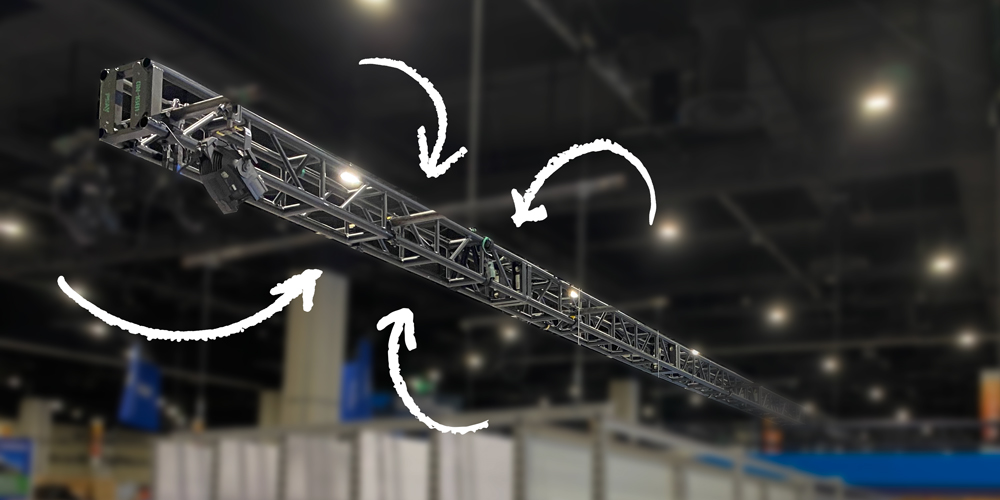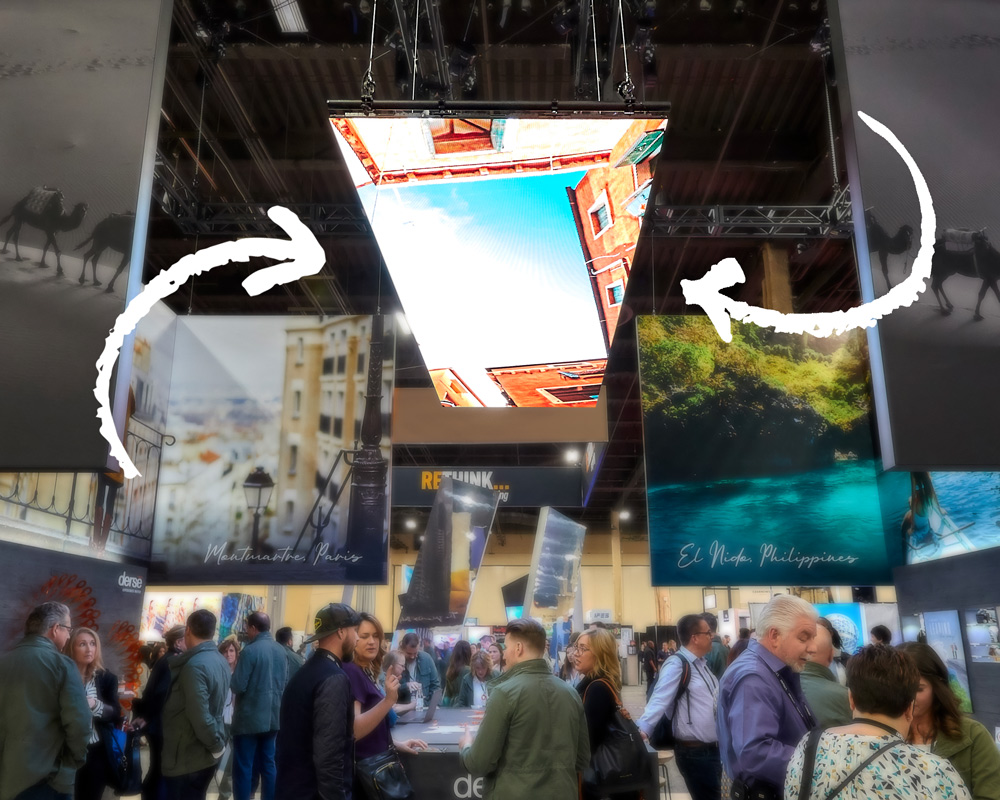What Is Trade Show Rigging and How Will It Impact My Budget?

I think we can agree that big picture trade show goals are good.
But if you neglect the tedious yet highly technical elements of your exhibit, your budget might suffer.
One way to mitigate (or at least plan for) budgetary overages is through gaining a better understanding of trade show rigging.
Quickly find what you're looking for:
What is Trade Show Rigging?
Trade show rigging refers to the suspension of your booth’s structures from the venue’s ceiling. The process of rigging can include different components to safely suspend booth elements:

Pick points are the point at which a structure is connected to cables and suspended from the ceiling

Truss is made of a series of triangles that distribute the weight of heavy exhibit structures
If you’ve ever used suspended elements in your booth, you likely depended on rigging to create a visually appealing and structurally sound exhibit.

Enhanced Environmental Lighting

Arches or Canopies

Hanging Signs

Video Displays or LED Walls

How is Rigging Regulated?
Within your show-specific ESM (exhibitor services manual), rigging regulations will be detailed to indicate venue-specific, general contractor-specific, and state-specific regulations. While your exhibit provider should have a comprehensive understanding of the rigging regulations for each of your shows, it’s important to pay attention to how the rigging regulations might differ across your show schedule.
Regulations might include engineer-stamped drawing requirements to ensure structural integrity or labor regulations for rigging companies. Different regulations have different cost implications.

How Does Rigging Impact Your Budget?
Rigging can impact your budget in five main ways:
1. Design complexity
2. Discrepancies in rigging regulations
3. Direct to show transportation
4. Remediating rigging mistakes
5. Cost of ownership of your exhibit
1. More complicated designs often mean more expensive installations. Rigging is no different.
Hanging signs with only two pick points will be less expensive than hanging signs with eight. When working through the design process, weigh the pros and cons of the visual impact your suspended elements will make and the expense they can rack up.
Heavier rigging installations will require truss to safely distribute and support the weight of the structures. Because truss requires more time to install, you can expect higher costs. In the interest of prioritizing safety on the show floor, general contractors may require truss for structures that didn’t need it previously.
2. Discrepancies in rigging regulations at different venues and among show organizers
Variations in rigging regulations will impact your budget. When engineer-stamped drawings are required, your trade show company will have to hire an engineer to review the structural integrity of your drawings.
Another wide variable can be the difference between the quote provided by a general contractor and the actual expense of rigging. Rigging costs will fluctuate and can even double compared to the quote due to rigging crew delays or miscalculations on the general contractor’s part. Your exhibit company can provide you with budgetary guidelines, but ultimately won’t have control over the final expense.
3. Transportation is a large part of your program’s budget both holistically and specifically for rigging
If you ship your properties direct to show, you run the risk that they might arrive late for a myriad of reasons beyond your control. If you have a labor team on the clock and your properties haven’t arrived, they’ll be running up your budget without any work getting done. And here’s the kicker – you’ll still have to wait for the rigging company (a separate labor crew from your standard I&D team) to finish the rigging (which goes up first) before your labor team can do the bulk of the installation.
Here’s how you can prevent this:
a. Ship your exhibit properties to the advanced warehouse to ensure they arrive at your booth space on time
b. Work with a trade show partner who has considered a plan B (and C) just in case your properties arrive late
4. What happens when the rigging is set up, booth installation has begun, and you notice a rigged element needs to be adjusted?
This is an important moment to consult with your account team to decide which is more important: finishing the booth on time and within budget or having these last-minute details modified to perfect your exhibit appearance. We know, a painful decision to make.
If you choose perfection, your labor expenses will likely climb due to the halt of installation and the wait for the rigging crew’s availability. Once the rigging is fixed, you might run into overtime or double-time labor expenses depending on the timing. Not ideal, but a flawless booth would still be possible.
5. How does the cost of owning your exhibit impact your rigging budget?
When you invest in a new exhibit, you’ll have the upfront investment of building the properties which is clearly listed in estimates and contracts and won’t come as a surprise.
What’s important to keep in mind is that costs like show services are recurring expenses. Rigging is one of them. Structures that require rigging will include rigging expenses at every show you attend. If you aren’t budgeting for these expenses, it’s a hard pill to swallow.
We packed a lot of info into one article! Let’s make sure we are on the same page:
- Get familiar with the regulations for your shows and identify which elements in your exhibit require rigging
- Have conversations with your trade show partner about regulations, the visual impact of your exhibit’s rigged elements, and a plan B for rigging mishaps during installation
- Update your budget to include rigging as an ongoing expense
Got it? Good!
Looking for more information about the cost drivers of your booth? We’ve covered that too.
Share this article